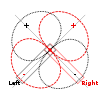
Microphone practice
Encyclopedia
There exist a number of well-developed microphone
techniques used for miking musical, film, or voice sources. Choice of technique depends on a number of factors, including:
or more for surround sound
. The artists need not perform in the same place at the same time, and individual tracks (or sections of tracks) can be re-recorded to correct errors. Generally effects such as reverberation
are added to each recorded channel, and different levels sent to left and right final channels to position the artist in the stereo sound-stage. Microphones may also be used to record the overall effect, or just the effect of the performance room.
This permits greater control over the final sound, but recording two channels (stereo recording) is simpler and cheaper, and can give a sound that is more natural.
(or loudness) difference between the two channels Δ L, and the time delay difference in arrival times for the same sound in each channel Δ t. The "interaural" signals (binaural ILD and ITD) at the ears are not the stereo microphone signals which are coming from the loudspeakers, and are called "interchannel" signals (Δ L and Δ t). These signals are normally not mixed. Loudspeaker signals are different from the sound arriving at the ear. See the article "Binaural recording for earphones
".
 Here there are two directional microphone
Here there are two directional microphone
s at the same place, and typically placed at 90° or more to each other. A stereo effect is achieved through differences in sound pressure level between two microphones. Due to the lack of differences in time-of-arrival and phase ambiguities, the sonic characteristic of X-Y recordings is generally less "spacey" and has less depth compared to recordings employing an AB setup.
 When the microphones are bidirectional and placed facing +-45° with respect to the sound source, the X-Y-setup is called a Blumlein Pair
When the microphones are bidirectional and placed facing +-45° with respect to the sound source, the X-Y-setup is called a Blumlein Pair
. The sonic image produced by this configuration is considered by many authorities to create a realistic, almost holographic soundstage.
A further refinement of the Blumlein Pair was developed by EMI
in 1958, who called it "Stereosonic". They added a little in-phase crosstalk above 700 Hz to better align the mid and treble phantom sources with the bass ones.
setup.
 This coincident technique employs a bidirectional microphone facing sideways and a cardioid (generally a variety of cardioid, although Alan Blumlein
This coincident technique employs a bidirectional microphone facing sideways and a cardioid (generally a variety of cardioid, although Alan Blumlein
described the usage of an omnidirectional transducer in his original patent) at an angle of 90° facing the sound source. One mic is physically inverted over the other, so they share the same distance. The left and right channels are produced through a simple matrix: Left = Mid + Side, Right = Mid − Side (the polarity-reversed side-signal). This configuration produces a completely mono-compatible signal and, if the Mid and Side signals are recorded (rather than the matrixed Left and Right), the stereo width can be manipulated after the recording has taken place. This makes it especially useful for film-based projects.
There is some controversy as to whether MS micing technique can create translation issues when used with matrix encoded cinema surround formats such as Dolby SR LtRt, which relies on phase relationships between left and right channels of the stereo recording in order to decode surround information.
The equipment for the techniques also varies from the bulky to the small and convenient.
A-B techniques generally use two separate microphone units, often mounted on a bar to define the separation. X-Y microphone capsules can be mounted in one unit, or even on the top of a handheld digital recorder. Since M/S setups can give a variable soundstage width, they are often used in small 'pencil microphones' to mount on video cameras, matching a zoom lens
.
Microphone
A microphone is an acoustic-to-electric transducer or sensor that converts sound into an electrical signal. In 1877, Emile Berliner invented the first microphone used as a telephone voice transmitter...
techniques used for miking musical, film, or voice sources. Choice of technique depends on a number of factors, including:
- The collection of extraneous noise. This can be a concern, especially in amplified performances, where audio feedbackAudio feedbackAudio feedback is a special kind of positive feedback which occurs when a sound loop exists between an audio input and an audio output...
can be a significant problem. Alternatively, it can be a desired outcome, in situations where ambient noise is useful (hall reverberation, audience reaction). - Choice of a signal type: MonoMonauralMonaural or monophonic sound reproduction is single-channel. Typically there is only one microphone, one loudspeaker, or channels are fed from a common signal path...
, stereoStereophonic soundThe term Stereophonic, commonly called stereo, sound refers to any method of sound reproduction in which an attempt is made to create an illusion of directionality and audible perspective...
or multi-channel. - Type of sound-source: Acoustic instruments produce a sound very different from electric instruments, which are again different from the human voice.
- Situational circumstances: Sometimes a microphone should not be visible, or having a microphone nearby is not appropriate. In scenes for a movie the microphone may be held above the pictureframe, just out of sight. In this way there is always a certain distance between the actor and the microphone.
- Processing: If the signal is destined to be heavily processed, or "mixed down", a different type of input may be required.
- The use of a windshield as well as a pop shieldPop filterA pop filter or pop shield is an anti-pop noise protection filter for microphones, typically used in a recording studio. It serves to reduce or eliminate 'popping' sounds caused by the mechanical impact of fast moving air on the microphone during recorded speech and singing. It can also protect...
, designed to reduce vocal plosives.
Basic techniques
There are several classes of microphone placement for recording and amplification.- In close micing, a microphone is placed relatively close to an instrument or sound source. This serves to reduce extraneous noise, including room reverberation, and is commonly used when attempting to record a number of separate instruments while keeping the signals separate, or when trying to avoid feedback in an amplified performance. Close micing often affects the frequency responseFrequency responseFrequency response is the quantitative measure of the output spectrum of a system or device in response to a stimulus, and is used to characterize the dynamics of the system. It is a measure of magnitude and phase of the output as a function of frequency, in comparison to the input...
of the microphone, especially for directional mics which exhibit bass boost from the proximity effectProximity effectProximity effect may refer to:*Proximity effect *Proximity effect , an increase in bass or low frequency response when a sound source is close to a microphone...
. - In ambient or distant micing, a microphone — typically a sensitive one — is placed at some distance from the sound source. The goal of this technique is to get a broader, natural mix of the sound source or sources, along with ambient sound, including reverberation from the room or hall.
Multi-track recording
Often each instrument or vocalist is miked separately, with one or more microphones recording to separate channels (tracks). At a later stage, the channels are combined ('mixed-down') to two channels for stereoSTEREO
STEREO is a solar observation mission. Two nearly identical spacecraft were launched into orbits that cause them to respectively pull farther ahead of and fall gradually behind the Earth...
or more for surround sound
Surround sound
Surround sound encompasses a range of techniques such as for enriching the sound reproduction quality of an audio source with audio channels reproduced via additional, discrete speakers. Surround sound is characterized by a listener location or sweet spot where the audio effects work best, and...
. The artists need not perform in the same place at the same time, and individual tracks (or sections of tracks) can be re-recorded to correct errors. Generally effects such as reverberation
Reverberation
Reverberation is the persistence of sound in a particular space after the original sound is removed. A reverberation, or reverb, is created when a sound is produced in an enclosed space causing a large number of echoes to build up and then slowly decay as the sound is absorbed by the walls and air...
are added to each recorded channel, and different levels sent to left and right final channels to position the artist in the stereo sound-stage. Microphones may also be used to record the overall effect, or just the effect of the performance room.
This permits greater control over the final sound, but recording two channels (stereo recording) is simpler and cheaper, and can give a sound that is more natural.
Stereo recording techniques
There are two features of sound that the human brain uses to place objects in the stereo sound-field between the loudspeakers. These are the relative levelLevel
Level or levels may refer to:-Places:*Levél, Győr-Moson-Sopron, Hungary*Level, Ohio, United States*Level Valley*Levels, West Virginia-Engineering-related:*Floor, or storey, of a building or a mine...
(or loudness) difference between the two channels Δ L, and the time delay difference in arrival times for the same sound in each channel Δ t. The "interaural" signals (binaural ILD and ITD) at the ears are not the stereo microphone signals which are coming from the loudspeakers, and are called "interchannel" signals (Δ L and Δ t). These signals are normally not mixed. Loudspeaker signals are different from the sound arriving at the ear. See the article "Binaural recording for earphones
Binaural
Binaural literally means "having or relating to two ears." Binaural hearing, along with frequency cues, lets humans and other animals determine direction of origin of sounds...
".
X-Y technique: intensity stereophony

Microphone
A microphone is an acoustic-to-electric transducer or sensor that converts sound into an electrical signal. In 1877, Emile Berliner invented the first microphone used as a telephone voice transmitter...
s at the same place, and typically placed at 90° or more to each other. A stereo effect is achieved through differences in sound pressure level between two microphones. Due to the lack of differences in time-of-arrival and phase ambiguities, the sonic characteristic of X-Y recordings is generally less "spacey" and has less depth compared to recordings employing an AB setup.

Blumlein Pair
Blumlein Pair is the name for a stereo recording technique invented by Alan Blumlein for the creation of recordings that, upon replaying through headphones or loudspeakers, recreate the spatial characteristics of the recorded signal....
. The sonic image produced by this configuration is considered by many authorities to create a realistic, almost holographic soundstage.
A further refinement of the Blumlein Pair was developed by EMI
EMI
The EMI Group, also known as EMI Music or simply EMI, is a multinational music company headquartered in London, United Kingdom. It is the fourth-largest business group and family of record labels in the recording industry and one of the "big four" record companies. EMI Group also has a major...
in 1958, who called it "Stereosonic". They added a little in-phase crosstalk above 700 Hz to better align the mid and treble phantom sources with the bass ones.
A-B technique: time-of-arrival stereophony
This uses two parallel omnidirectional microphones some distance apart, so capturing time-of-arrival stereo information as well as some level (amplitude) difference information, especially if employed close to the sound source(s). At a distance of about 50 cm (0.5 m) the time delay for a signal reaching first one and then the other microphone from the side is approximately 1.5 ms (1 to 2 ms). If the distance is increased between the microphones it effectively decreases the pickup angle. At 70 cm distance it is about equivalent to the pickup angle of the near-coincident ORTFORTF stereo technique
The ORTF stereo microphone system is a microphone technique used to record stereo sound.It was devised around 1960 at the Office de Radiodiffusion Télévision Française at Radio France....
setup.
M/S technique: Mid/Side stereophony

Alan Blumlein
Alan Dower Blumlein was a British electronics engineer, notable for his many inventions in telecommunications, sound recording, stereo, television and radar...
described the usage of an omnidirectional transducer in his original patent) at an angle of 90° facing the sound source. One mic is physically inverted over the other, so they share the same distance. The left and right channels are produced through a simple matrix: Left = Mid + Side, Right = Mid − Side (the polarity-reversed side-signal). This configuration produces a completely mono-compatible signal and, if the Mid and Side signals are recorded (rather than the matrixed Left and Right), the stereo width can be manipulated after the recording has taken place. This makes it especially useful for film-based projects.
There is some controversy as to whether MS micing technique can create translation issues when used with matrix encoded cinema surround formats such as Dolby SR LtRt, which relies on phase relationships between left and right channels of the stereo recording in order to decode surround information.
Choosing a technique
If a stereo signal is to be reproduced in mono, out-of-phase parts of the signal will cancel, which may cause the unwanted reduction or loss of some parts of the signal. This can be an important factor in choosing which technique to use.- Since the A-B techniques use phase differences to give the stereo image, they are the least compatible with mono.
- In the X-Y techniques, the microphones would ideally be in exactly the same place, which is not possible – if they are slightly separated left to right, there may be some loss of high frequencies when played back in mono, so they are often separated vertically. This only causes problems with sound from above or below the height of the microphones.
- The M/S technique is ideal for mono compatibility, since summing Left+Right just gives the Mid signal back.
The equipment for the techniques also varies from the bulky to the small and convenient.
A-B techniques generally use two separate microphone units, often mounted on a bar to define the separation. X-Y microphone capsules can be mounted in one unit, or even on the top of a handheld digital recorder. Since M/S setups can give a variable soundstage width, they are often used in small 'pencil microphones' to mount on video cameras, matching a zoom lens
Zoom lens
A zoom lens is a mechanical assembly of lens elements for which the focal length can be varied, as opposed to a fixed focal length lens...
.
External links
- Michael Williams, The Stereophonic Zoomhttp://www.rycote.com/images/uploads/The_Stereophonic_Zoom.pdf
- Visualization XY Stereo System - Blumlein Eight/Eight 90° - Intensity Stereo

